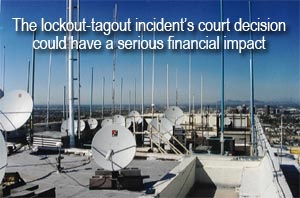|
Court's RF exposure ruling could have significant financial impact for the wireless industry
August 23, 2007 - Stemming from a 1998 incident, the Alaska Supreme Court last month affirmed a state ruling awarding an AT&T Inc. equipment installer total  disability and medical benefits as a result of health problems tied to exposure to radio frequency radiation levels deemed to be slightly above those set by the Federal Communications Commission. disability and medical benefits as a result of health problems tied to exposure to radio frequency radiation levels deemed to be slightly above those set by the Federal Communications Commission.
The court's decision to uphold Alaska's Workers' Compensation Board has potentially major implications for the tower construction and maintenance industry, according to a consumer advocacy group specializing in wireless health issues.
Case seen as precedent-setting
"This decision is significant because the FCC RF limit is designed to keep people from being heated, and ignores evidence of other adverse biological effects at much lower levels," stated The EMR Policy Institute.
The group added: "This precedent-setting case opens the door for any wireless industry or maintenance worker who has been exposed to antenna arrays on the job site that have not been shut off to file disability claims should they suffer similar cognitive and neurological symptoms. U.S. wireless service providers are not required to document compliance with FCC RF safety limits by on-site radiation measurements. Millions of workers occupy worksites on a daily basis where operating antenna arrays are camouflaged and where no workplace RF safety program is carried out."
Although the AT&T Alascom issue involved the installation of a new computer-operating switching system in the Eagle River earth station, where waveguide was being replumbed, the legal and policy issues are relevant for wireless health across the board in the telecom sector.
According to the EMRPI group, the RF exposure level in question was well below FCC's recognized level of "thermal" harm. Although the FCC contends there are no scientifically established harmful health effects below the thermal threshold, the advocacy group says the Board's decision concurs with medical experts who found adverse RF health effects from exposure occurring above the FCC safety limit but below the thermal threshold.
"This decision could hold significant financial impact for the wireless industry going forward," they said.
The court's decision opens the door for disability claims from wireless industry or maintenance workers who experience occupational exposures to operating antenna arrays and have suffered similar cognitive and neurological symptoms, stated the EMRPI.
According to the court documents, on November 16, 1998, John Orchitt and his coworker, Tim Sorenson, were installing a new computer-operated switching system in the Eagle River Earth Station and had to replumb sections of waveguide.
To prevent them from being exposed to radio frequency radiation, the amplifier associated with the waveguide they were working on was supposed to be turned off.
After a technician from the earth station turned off an amplifier in accordance with the specifications provided, Orchitt separated two sections of the waveguide. He estimated that his head was from nine to fifteen inches away from the
waveguide's point of separation.
While Orchitt was working on the waveguide, Sorenson walked around the room with a meter and probe to detect any radio frequency radiation. The meter Sorenson used had three scales. A full-scale reading on the highest scale could indicate the presence of three times the American National Standards Institute (ANSI) limit for whole body exposure.
Sorenson calibrated the meter outside the room. After he reentered the room, the meter "pegged," indicating that there was radio frequency radiation in the room. "Pegged" means the meter registered at its highest level. Sorenson changed the scale while he was in the room, but the meter continued to peg, according to the court decision.
Realizing there was a problem, Orchitt clamped the two pieces of the waveguide together to stop the radiation from leaking any further. Orchitt and Sorenson then discovered that the amplifier connected to the waveguide had not been turned off because the engineer had misidentified which amplifier was associated with the waveguide they
were working on.
Orchitt contacted the engineer and tried to contact his supervisor to tell them about the accident; his supervisor was not in, so he contacted the manager instead. The radio frequency radiation Orchitt was exposed to had a frequency of six gigahertz; the amplifier transmitting radio frequency radiation through the waveguide.
Orchitt applied for workers' compensation benefits on September 21, 1999, claiming he had suffered head, brain, and upper body injuries as a result of overexposure to radio frequency radiation.
To read the full Alaska State Supreme Court decision, click here .
|